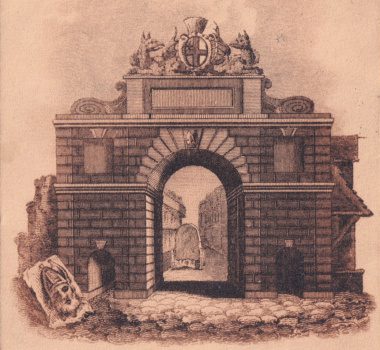Bishopsgate
Bishopsgate was the original gate of London on the road heading in the direction of Lincoln and the north-east of England.

Bishopsgate led out to the Roman road towards Lincoln and York that later became known as Ermine Street, with the section immediately inside and outside of the gate known as Bishopsgate Street. The road still passes in a straight line, northwards through North London. As with Newgate and Aldgate, Bishopsgate was probably a busy place during the height of Roman Londinium and again during the Middle Ages.
The person who gave Bishopsgate its name is possibly the 7th century Bishop of London Erkenwald, who the Tudor historian John Stowe believed to have built the Saxon-period structure, and who is said to have exacted a toll of one piece of wood from each cart entering the city. Stowe also believed it to have been repaired during the reign of William the Conqueror.
The gate stood at what is now the junction of Wormwood Street and Camomile Street. During the Middle Ages they formed part of a long street that ran inside the wall from Cripplegate to Moorgate, Bishopsgate and Aldgate, and largely still exists under different names. Outside of the wall between Bishopsgate and Aldgate was a long ditch that was used as a dumping ground by Londoners.
During the medieval period merchants from Germanic countries, who became known as the Hanse, were trading with London and they set up a riverside base where the River Walbrook flowed into the Thames. A disagreement that lasted several years regarding their rights in England was settled by the Exchequer in July 1282, whereby the Hanse were required to pay 210 marks to maintain Bishopsgate. In return they were freed from payments of murage, the tax to maintain the city walls and civic buildings. Bishopsgate was rebuilt in 1479 by the Hanse according to Stowe. It was due to be rebuilt again by the merchants in 1551 but their rights were taken away during the reign of the young Edward VI so the old gate remained.
Throughout the Middle Ages, above the gateway on each of the north and south sides was a figure of a bishop, possibly Erkenwald, and William the Norman. There were also stone statues believed to be King Alfred and Aelred, King of Mercia, as well as the City’s coat of arms. As with other gates, Bishopsgate contained residential rooms, often occupied by City officials. Repairs were undertaken in 1648 and in 1731 Bishopsgate was completely rebuilt to a simpler design without battlements.
By the 16th century Bishopsgate Street, both north and south of the gate, was lined with buildings, some of which were impressive residences. Outside the gate were numerous inns, brothels, bull and bear-baiting rings, and skittle and bowling alleys. A major incident took place at the Bull Inn during April 1649 when some Parliamentary troops rebelled due to lack of pay. They barricaded themselves in the inn but surrendered when Sir Thomas Fairfax, Commander-in-Chief of the army, and Oliver Cromwell, arrived. The rebel leader was executed the following day.
St. Botolph-without-Bishopsgate was founded in Saxon times on the west side of Bishopsgate Street, one of three surviving churches outside of the city gates dedicated to the patron saint of travellers. The medieval building escaped the Great Fire but was rebuilt and completed in 1728, at which time the Saxon foundations were discovered.
There had been a Roman cemetery outside of the city wall, to the east of Bishopsgate Street, which was also used as a burial ground during the medieval period. The Priory of St. Mary Spital was founded there during the 12th century. It grew into a major institution, where canons and lay sisters cared for the sick, and particularly as a lying-in hospital for woman giving birth. Following its dissolution by Henry VIII the open fields around the priory continued to be known as Spitalfields.
Another priory outside the city wall that became a major hospital was St. Mary Bethlehem on the western side of Bishopsgate Street, founded in 1247. It specialised in caring for those with mental illness and became known as Bethlem Hospital, or ‘Bedlam’. Liverpool Street station now stands on the site of St. Mary Bethlehem.
In the early 12th century Holywell Priory was established further north along Bishopsgate Street. That area was Shoreditch, which became a popular recreational area for Londoners and where in 1576 the first purpose-built playhouse, the Theatre, was built by impresario James Burbage. It was where William Shakespeare first established his reputation.
Bishopsgate was demolished in 1760 and its location at the junction of Bishopsgate and Wormwood Street is now marked with a bronze bishop’s mitre on the side of a building.
<Back to The City Wall and Gates of London
Sources include:
- Alan Brooke ‘Gates of the City of London’
- Walter Thornbury ‘Old & New London’
- John Stow ‘A Survey of London’ (1598)
- Stephen Millar ‘London’s City Churches’


